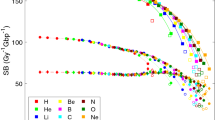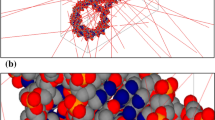Abstract
We present a track structure model based on the local dose deposited around heavy ion tracks to explain the cross sections for single-strand and double-strand break induction in plasmid DNA in different aqueous buffers. The model is based only on measurable quantities, namely the effect distribution for inducing strand breaks after x-ray irradiation as a function of dose, and the radial dose distribution of the heavy ion track. The effect of indirect DNA damage mediated by free radicals produced in the water surrounding the DNA is accounted for by allowing the radial dose distribution to be smeared in space by an effective target size corresponding to the squared sum of the geometrical extension of the plasmid molecule and the mean free drift path of the radicals in the buffer solution. Our calculations reproduce well the measured cross sections for single-strand and double-strand break induction in SV40 plasmid DNA in various buffer solutions both as a function of the LET and of the specific energy of the heavy ion.
Similar content being viewed by others
Abbreviations
- TE buffer :
-
10−2 mol dm−3 Tris, 10−3 mol dm−3 EDTA, pH 7.9
- EO buffer :
-
5×10−4 mol dm−3 Tris, 10−4 mol dm−3 MgCl2, pH 7.4–7.6.
References
Roots R, Holley W, Chatterjee A, Rachal E, Kraft G (1989) The influence of radiation quality on the formation of DNA breaks. Adv Space Res 9:45–55
Christensen RC, Tobias CA, Taylor WD (1972) Heavy-ion-induced single- and double-strand breaks in PhiX-174 replicative form DNA. Int J Radiat Biol 22:457–477
Tancher-Scholz G, Kraft G (1999) Influence of radiation quality on the yield of DNA strand breaks in SV40 DNA irradiated in solution. Radiat Res 151:595–604
Katz R, Kobetich EJ (1969) Particle tracks in emulsion. Phys Rev 186:344–351
Geiß O, Krämer M, Kraft G (1998) Efficiency of thermoluminescent detectors to heavy-charged particles. Nucl Instrum Methods Phys Res B 142:592–598
Spielberger B, Scholz M, Kramer M, Kraft G (2002) Calculation of the x-ray film response to heavy charged particle irradiation. Phys Med Biol 47:4107–4120
Zhang Ch, Dunn DE, Katz R (1985) Radial distribution of dose and cross-sections for the inactivation of dry enzymes and viruses. Radiat Prot Dosim 13:215–218
Scholz M, Kraft G (1996) Track structure and the calculation of biological effects of heavy charged particles. Adv Space Res 18:5–14
Katz R, Wesely S (1991) Cross sections for single and double strand breaks in SV-40 virus in EO buffer after heavy ion irradiation: experiment and theory. Radiat Environ Biophys 30:81–85
Wingate CL, Baum JW (1976) Measured radial distributions of dose and LET for alpha and proton beams in hydrogen and tissue-equivalent gas. Radiat Res 65:1–19
Varma MN, Baum JW, Kuehner AV (1977) Radial dose, LET, and W for 16O ions in N2 and tissue-equivalent gases. Radiat Res 70:511–518
Varma MN, Baum JW (1980) Energy deposition in nanometer regions by 377 MeV/nucleon20Ne ions. Radiat Res 81:355–363
Varma MN, Baum JW, Kuehner AV (1980) Stopping power and radial dose distribution for 42 MeV bromine ions. Phys Med Biol 25:651–656
Wilson WE, Paretzke HG (1981) Calculation of distributions for energy imparted and ionization by fast protons in nanometer sites. Radiat Res 87:521–537
Hamm RN, Turner JE, Ritchie RH, Wright HA (1985) Calculation of heavy-ion tracks in liquid water. Radiat Res [Suppl 8]:S20-S26
Krämer M, Kraft G (1994) Calculations of heavy-ion track structure. Radiat Environ Biophys 33:91–109
Wilson WE, Nikjoo H (1999) A Monte Carlo code for positive ion track simulation. Radiat Environ Biophys 38:97–104
Kiefer J, Straaten H (1986) A model of ion, track structure based on classical collision dynamics. Phys Med Biol 31:1201–1209
Sonntag C von (1987) The chemical basis of radiation biology. Taylor & Francis, London
Schwarz HA (1969) Applications of the spur diffusion model to the radiation chemistry of aqueous solutions. J Phys Chem 73:1928–1937
Kellerer AM (1977) Microdosimetric concepts relevant to HZE-particles. In: Proceedings of the European Symposium on Life Sciences Research in Space. Cologne Porz
La Verne JA (2000) Track effects of heavy ions in liquid water. Radiat Res 153:487–496
Waligorski MPR, Hamm RN, Katz R (1986) The radial distribution of dose around the path of a heavy ion in liquid water. Nucl Tracks Radiat Meas 11:309–319
Shao C, Saito M, Yu Z (1999) Formation of single- and double-strand breaks of pBR322 plasmid irradiated in the presence of scavengers. Radiat Environ Biophys 38:105–109
Milligan JR, Aguilera JA, Wu CC, Ng JY, Ward JF (1996) The difference that linear energy transfer makes to precursors of DNA strand breaks. Radiat Res 145:442–448
Schmidt JB (1993) Heavy ion induced lesions in DNA: a theoretical model for the initial induction of DNA strand breaks and chromatin breaks. University of California, Berkley
Fulford J, Nikjoo H, Goodhead DT, O’Neill P (2001) Yields of SSB and DSB induced in DNA by Al(K) ultrasoft X-rays and alpha-particles: comparison of experimental and simulated yields. Int J Radiat Biol 77:1053–1066
Kellerer AM, Rossi HH (1978) A generalized formulation of dual radiation action. Radiat Res 75:471–488
Zaider M (1992) The application of the principle of “dual radiation action” in biophysical modelling. In: Chadwick KH, Moschini G, Varma MN. Biophysical modelling of radiation effects. Adam Hilger, Bristol, Philadelphia, New York, pp 37–45
Kampf G (1988) Induction of DNA double-strand breaks by ionizing radiation of different quality and their relevance for cell inactivation. Radiobiol Radiother (Berl) 29:631–658
Heilmann J, Taucher-Scholz G, Kraft G (1995) Induction of DNA double-strand breaks in CHO-K1 cells by carbon ions. Int J Radiat Biol 68:153–162
Brons S, Jakob B, Taucher-Scholz G, Kraft G (2001) Heavy ion production of single- and double-strand breaks in plasmid DNA in aqeous solution. Phys Med 17 [Suppl 1]:217–218
Author information
Authors and Affiliations
Corresponding author
Additional information
Published online: 12 March 2003
Rights and permissions
About this article
Cite this article
Brons, S., Taucher-Scholz, G., Scholz, M. et al. A track structure model for simulation of strand breaks in plasmid DNA after heavy ion irradiation. Radiat Environ Biophys 42, 63–72 (2003). https://doi.org/10.1007/s00411-003-0184-9
Received:
Accepted:
Issue Date:
DOI: https://doi.org/10.1007/s00411-003-0184-9




